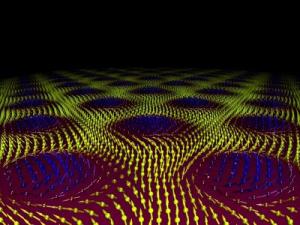Dec 20 2010
One of the requirements to keep trends in computer technology on track – to be ever faster, smaller, and more energy-efficient – is faster writing and processing of data.
In the Dec. 17 issue of the journal Science, physicists at the Technische Universitaet Muenchen (TUM) and the Universitaet zu Koeln report results that could point the way to a solution.
 This illustration shows how magnetic vortices in manganese silicon form a regular lattice.
This illustration shows how magnetic vortices in manganese silicon form a regular lattice.
TUM physicists set a lattice of magnetic vortices in a material in motion using electric current almost a million times weaker than in earlier studies. They observed the coupling between electric current and magnetic structure by means of measurements at the research neutron source FRM II at the TUM in Garching.
While Peter Gruenberg and Albert Fert were awarded the Nobel Prize in 2007 for research that led to significantly faster reading of data, in the past few years scientists have been concentrating on how magnetic information can be directly written to media using electric current. So far, the problem with this kind of work has been the need for extremely high currents, whose side effects are nearly impossible to rein in, even in nanostructures.
A little over a year ago, Professor Christian Pfleiderer and his team at the Physics Department of the TUM discovered an entirely new magnetic structure in a crystal of manganese silicon – a lattice of magnetic vortices. The experiments in Garching were spurred by the theoretical forecasts of Professor Achim Rosch at the Universitaet zu Koeln and Professor Rembert Duine from the Universiteit Utrecht. They were expecting new results in the field of so-called spintronics, nanoelectronic elements that use not only the electric charge of electrons to process information, but also their magnetic moment, or spin.
Christian Pfleiderer's team of scientists sent electric current through the manganese silicon. Using neutrons from FRM II, they were able to observe a twist in the magnetic vortex lattice, which they could not explain initially. More interesting than the twist was the newly discovered magnetic lattice (Science, Vol. 323, 5916 pp. 915-919, see below).
In the next step, Christian Pfleiderer and his team made further measurements at the MIRA instrument of the neutron source FRM II in an attempt to determine why the lattice twisted when a current was applied. At first, the calculations of the theoreticians contradicted the results of the experiments in Garching. "The magnetic structure twists, because the direction of the electric current is deflected extremely efficiently by quantum mechanical effects," explains Christian Pfleiderer. When an electron flies through the magnetic vortex, the electron's spin reacts to the vortex (see animation). In this way the electric current exerts a force on the magnetic vortices, which eventually begin to flow.
After further measurements, the team of Christian Pfleiderer and Achim Rosch was able to establish that the newly discovered lattice of magnetic vortices displays properties that have been of interest in nanotechnology for quite some time. They are, among other things, relevant to the development of new data storage systems. Notably, the magnetic vortices are very stable and at the same time very weakly anchored in the material, so that even the weakest of electric currents can lead to movement. This should allow data to be written and processed considerably faster and more efficiently in the future.